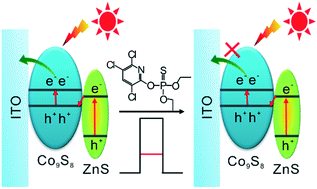A direct Z-scheme ZnS/Co9S8 heterojunction-based photoelectrochemical sensor for the highly sensitive and selective detection of chlorpyrifos†
Abstract
The detection of chlorpyrifos is of great importance due to its massive usage and serious toxic effects on human health and the ecosystem. Although fruitful achievements have been made in the photoelectrochemical (PEC) sensing of chlorpyrifos, the construction of a label-free PEC interface with high sensitivity and selectivity still faces serious challenges. In this work, we design a direct Z-scheme ZnS/Co9S8 heterojunction with hollow cubic structures, and the PEC sensor based on such materials achieves the highly sensitive and selective detection of chlorpyrifos through the inhibition to the photoresponse of ZnS/Co9S8 by chlorpyrifos. For sensitivity, the hollow cubic structures of the heterojunction increase the light absorption, and the formation of a direct Z-scheme of the photocatalysts greatly improves the spatial separation of photogenerated charge carriers, thus achieving better PEC activity and higher photocurrent response of the heterojunction than those of individual materials. It shows a wide linear range from 0.05 ppb to 40 ppb with a detection limit as low as 0.0166 ppb (defined as S/N = 3). In particular, the specific interaction between ZnS/Co9S8 and N and S atoms of chlorpyrifos creates the high selectivity for chlorpyrifos. In addition, the PEC sensor is still stable after storage for two weeks.

- This article is part of the themed collection: Environmental Science: Nano Cover Art


 Please wait while we load your content...
Please wait while we load your content...